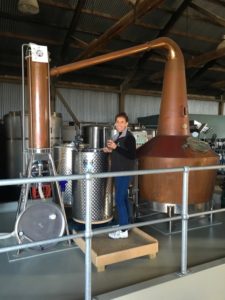If cooking is a passion, choosing the oven in your kitchen is a big deal. Baked items whether mains, deserts, snacks or sweet or savoury, your confidence in the outcome is based on how reliable the oven is and your familiarity using it. The same analogy can be drawn when choosing a still. However stills are not just an order in, organise an electrician, plug in and away you go job. No…
In organising a new still so many considerations need to be taken into account. Electricity supply to heat the still, water flow and recycling of chilling of water to the cooling tower, layout and design of the still to work efficiently with the output of the brew house and efficient quantities supplied to the spirit still. In our minds, locality and the ability to continue to offer a unique tourism experience within the heritage fabric of the Railway Goods Shed are also important.
For someone who is very spatially challenged (There are a whole stack of funny stories to tell!) I am growing more familiar with how the new still will feel in our site now because we have been constantly talking, measuring, spread-sheeting and redoing these to tweak things. There will probably be a whole lot more of this to perfect the optimum still size and floor layout!

Fleurieu Distillery’s 12 hectolitre still
The elegant copper still photographed here was designed and made by Peter Bailly from Knapp Lewer in Tasmania. Working in conjunction with a number of distilleries both in Tasmania and the mainland, Peter has a wealth of knowledge. To be able to tap into this is invaluable as there are so many aspects to creating great new make spirit. His ability to customise the still to suit location, shape and still design are pivotal in the long term of whisky design and the individual fingerprint of a distillery.
The stills that whisky wash and low wines are distilled on, ultimately help to form the tasting profile of the spirit. This is determined by the heating of the pot, the diameter, shape and curvature of the still’s neck, the rate of fall and length of the line arm to the cooling tower, just to name a few. All play a part in the complexities that make up this precious dram and the overall quality of new make spirit.
From my beginner’s understanding, the structural proportions of a still determine spirit tasting profiles. A taller graceful neck and long line arm to the cooling tower will produce more delicate spirit where a shorter neck will produce a heavier oilier spirit with different flavour characteristics (Check out whiskyscience.blogspot.com.au as it offers great insight into the science of stills and distilling)
We are very happy with the quality of spirit that our current still produces. It already has depth and sweetness before going into the barrel. To maintain this we are looking at a larger still with exactly the same shape and neck curvatures to distil the wash to low wines and using our current 12 hectolitre still to do the final spirit run.
As we head into the depths of winter now with multiple layers of clothing, by the end of an icy day in the distillery a golden dram of whisky is more than welcome. Whisky’s gorgeous copper glow and depth of flavour can be attributed to time and place in barrel aging but spirit character and mouth feel can also be accredited to the still it originated from. Another good reason to enjoy a dram and contemplate all things whisky I think!
Cheers!






I love this! Your words are fitting and I look forward to following your journey.
Whisky brings people together and encourages us to share stories.
Thanks Peter 🙂